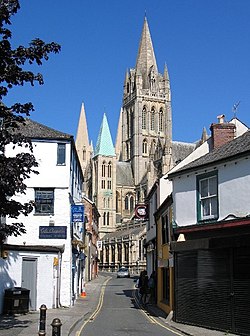Diocese of Truro Dioecesis Truronensis Epskobeth Truru | |
|---|---|
 Truro Cathedral seen from St Mary's Street. It was built between 1880 and 1910. | |
 Coat of arms | |
 Flag | |
| Location | |
| Country | England |
| Ecclesiastical province | Canterbury |
| Archdeaconries | Bodmin, Cornwall |
| Coordinates | 50°14′24″N5°01′05″W / 50.240°N 5.018°W |
| Statistics | |
| Parishes | 225 |
| Churches | 313 |
| Schools | 12 Church of England schools 12 Multi-academy trusts |
| Information | |
| Formation | 15 December 1876 |
| Denomination | Church of England |
| Established | 1877 [1] |
| Cathedral | Truro Cathedral |
| Language | English, Cornish |
| Current leadership | |
| Bishop | David Williams, Bishop of Truro |
| Suffragan | Hugh Nelson, Bishop of St Germans |
| Archdeacons | Clive Hogger, Archdeacon of Cornwall Archdeacon of Bodmin (vacant) |
| Website | |
| trurodiocese | |
| Bishopric of Truro Act 1876 | |
|---|---|
| Act of Parliament | |
 | |
| Long title | An Act to provide for the Foundation of a new Bishopric out of a part of the diocese of Exeter. |
| Citation | 39 & 40 Vict. c. 54 |
| Dates | |
| Royal assent | 11 August 1875 |
| Other legislation | |
| Amended by | Statute Law Revision Act 1883 |
| Text of statute as originally enacted | |
The Diocese of Truro (established 1876) is a Church of England diocese in the Province of Canterbury which covers Cornwall, the Isles of Scilly and a small part of Devon. The bishop's seat is at Truro Cathedral.
Contents
- Geography and history
- Bishops
- Suffragan Bishop
- Provincial Episcopal Visitor
- Other bishops in the Diocese
- Archdeaconries and deaneries
- Rural deaneries
- Coat of arms
- Future
- Jeremy Dowling review
- List of churches in the diocese
- Deanery of Stratton
- Deanery of Trigg Major
- Deanery of Trigg Minor & Bodmin
- Deanery of East Wivelshire
- Deanery of West Wivelshire
- Deanery of Carnmarth North
- Deanery of Carnmarth South
- Deanery of Kerrier
- Deanery of Penwith
- Deanery of Powder
- Deanery of Pydar
- Deanery of St Austell
- Benefices by population
- Deaneries by population
- Archdeaconries by population
- See also
- References
- Further reading
- External links
